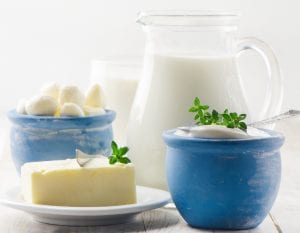 The rate of milk production growth began to moderate during the first quarter, but additional milk production continues to generate American cheese at a faster rate than total consumption, driving up inventories and putting some pressure on cheese prices. Still, exports of most products showed strong year-over-year growth during the first quarter of 2017. Federal order Class prices have dropped month-to-month during most of 2017, and the March all-milk price was $1.60 per hundredweight under January. The March Margin Protection Program (MPP) margin was down $1.75 per hundredweight from last December. However, a mid-May rally in cash and futures prices for butter and Cheddar cheese provided a strong indication that the milk price erosion during the first months of this year may have run its course.
The rate of milk production growth began to moderate during the first quarter, but additional milk production continues to generate American cheese at a faster rate than total consumption, driving up inventories and putting some pressure on cheese prices. Still, exports of most products showed strong year-over-year growth during the first quarter of 2017. Federal order Class prices have dropped month-to-month during most of 2017, and the March all-milk price was $1.60 per hundredweight under January. The March Margin Protection Program (MPP) margin was down $1.75 per hundredweight from last December. However, a mid-May rally in cash and futures prices for butter and Cheddar cheese provided a strong indication that the milk price erosion during the first months of this year may have run its course.
Commercial Use of Dairy Products
Sales of all fluid products were down by 1.3 percent from a year earlier during December 2016–February 2017, on a leap year-adjusted basis. Despite monthly variations, the first total fluid sales volumes have trended down by just under 1 percent per year on a fairly steady basis over the past year. Commercial use of most products was down from a year earlier during December 2016–February 2017. February 2017 was the first time since August 2014 that domestic use of all cheese was lower than a year ago. This drop has been attributed to weak sales at retail during the first few months of this year.
U.S. Dairy Trade
The annual growth rate of U.S. cheese exports has been increasing steadily since early in 2016, reaching 13 percent during the first quarter of 2017. Both American-type and other cheese have shown constant acceleration of export growth. Dry milk and dry whey products were up over a year ago by more than 50,000 tons. The percent of domestic milk solids production exported has increased steadily since the summer of 2016.
Butter and cheese imports continue to drop as world prices for these products recover relative to domestic prices. Imports of concentrated milk protein products remain on a growth track, driven by increases in domestic sales of the products in which they are used.
Milk Production
 U.S. milk production during the first quarter of 2017 was 2.1 percent higher than during 2016’s first quarter, on a leap year-adjusted basis. On a monthly basis, production was up by 2.6 percent in January, the highest since December 2014. Year-over-year growth dropped to a leap year-adjusted 2.2 percent in February, and then to 1.7 percent in March. This marked slowing of milk production growth in the United States is caused by changes in state milk production. Based on USDA revisions in data for the past several years, the rate of production growth is increasing in several of the smaller milk producing states but only in very few of the larger ones. Growth in milk production per cow is also dropping. Partly but not fully offsetting this is a very gradual increase in dairy cow numbers at the national level. These are all indicators that financial conditions on dairy farms over the past several years, from the standpoint of margins, are not at a level that will stimulate the sustained expansion of milk production at the national level.
U.S. milk production during the first quarter of 2017 was 2.1 percent higher than during 2016’s first quarter, on a leap year-adjusted basis. On a monthly basis, production was up by 2.6 percent in January, the highest since December 2014. Year-over-year growth dropped to a leap year-adjusted 2.2 percent in February, and then to 1.7 percent in March. This marked slowing of milk production growth in the United States is caused by changes in state milk production. Based on USDA revisions in data for the past several years, the rate of production growth is increasing in several of the smaller milk producing states but only in very few of the larger ones. Growth in milk production per cow is also dropping. Partly but not fully offsetting this is a very gradual increase in dairy cow numbers at the national level. These are all indicators that financial conditions on dairy farms over the past several years, from the standpoint of margins, are not at a level that will stimulate the sustained expansion of milk production at the national level.
Dairy Products
Additional milk production continued to move mostly into the production of American-type cheese, particularly Cheddar, which increased by almost 8 percent in the first quarter of 2017 from a year ago. Butter production increased from a year ago during the quarter, after being down on a rolling three-month basis since late last summer. Increased production of non-fat dry milk and skim milk powder matches closely the difference between increased exports and reduced domestic use of these two products.










